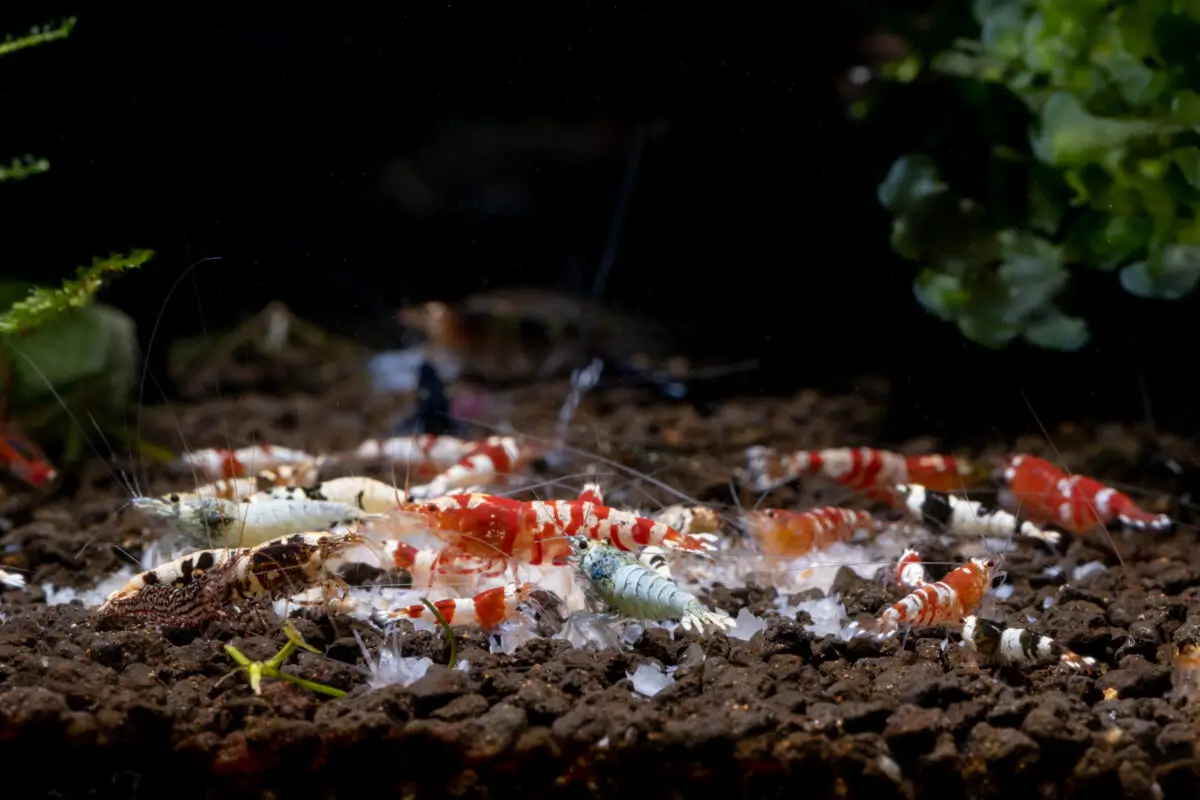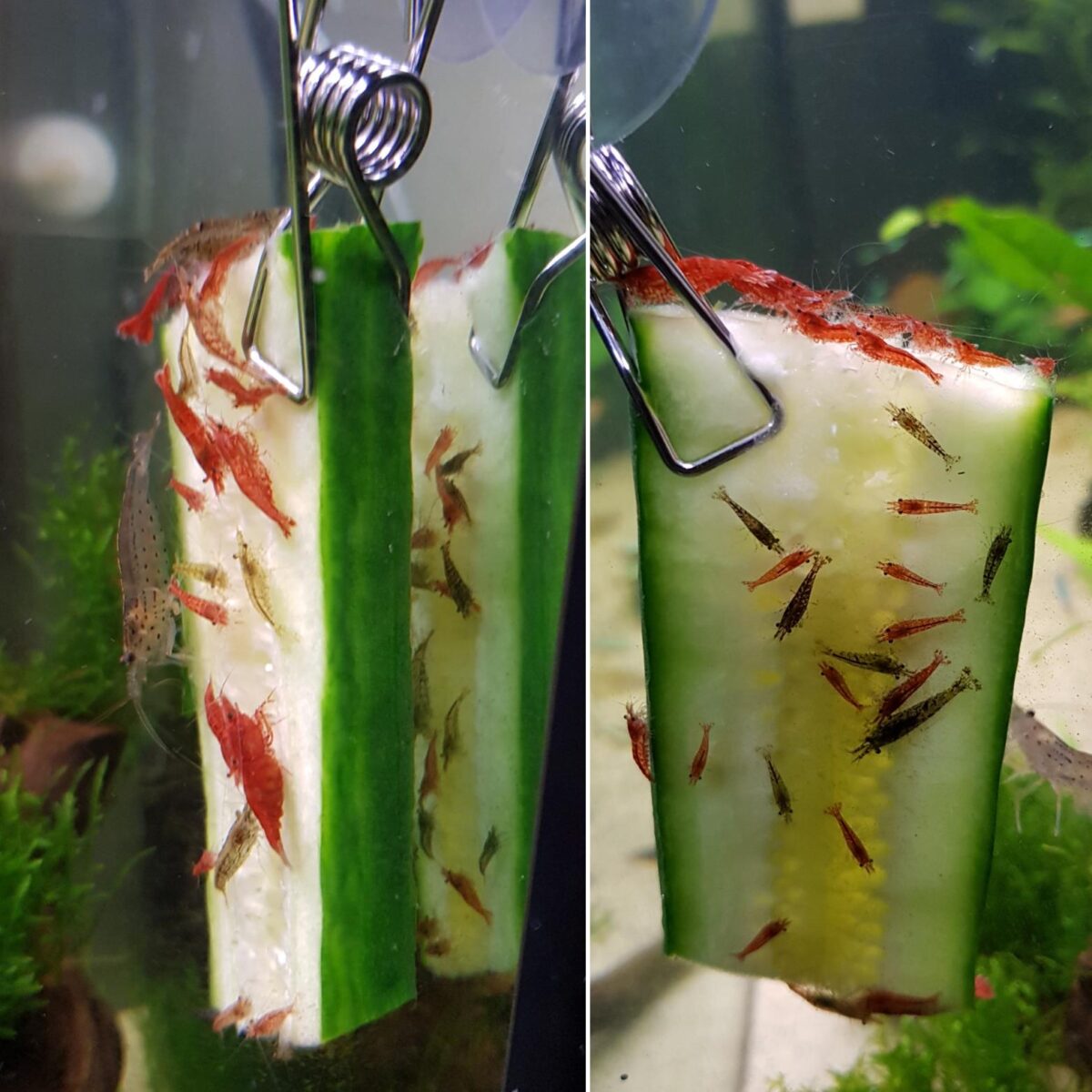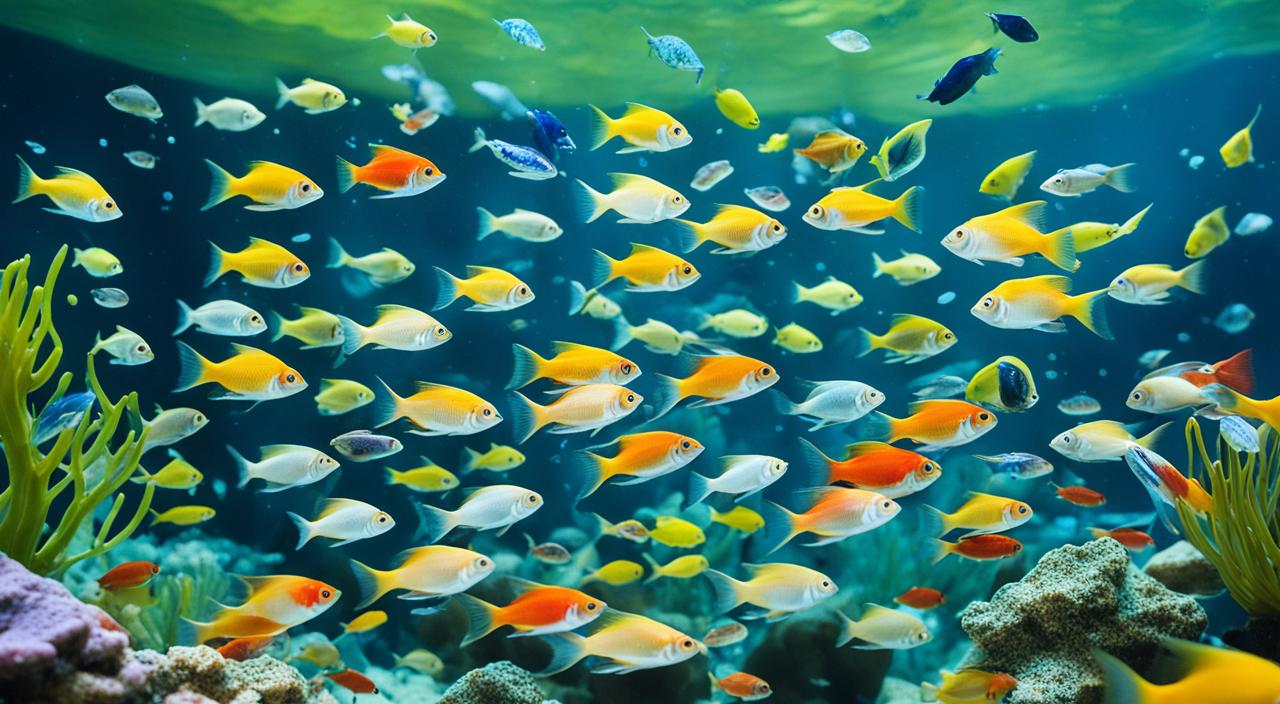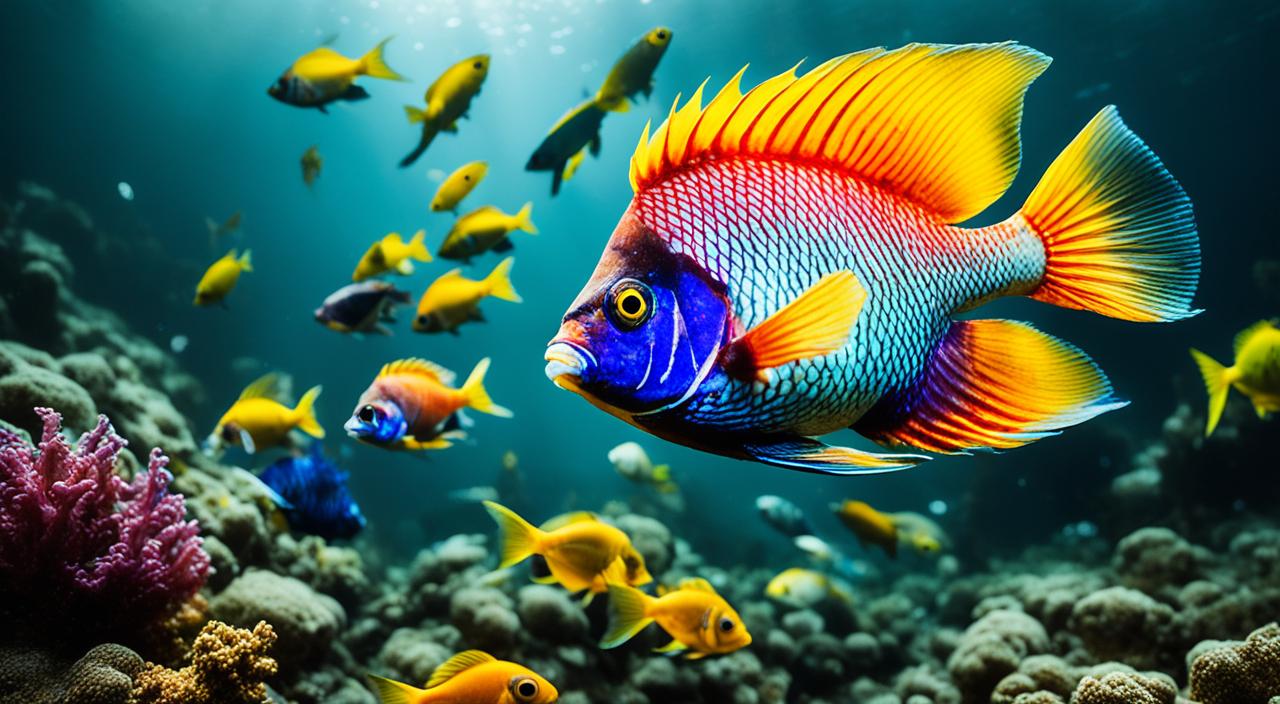Did you know that the proper feeding schedule can significantly impact the health and vitality of your shrimp? Many shrimp keepers overlook the importance of an appropriate feeding routine, leading to poor growth, weakened immunity, and even death.
To ensure that your shrimp thrive in their aquatic environment, it’s crucial to understand their nutritional requirements, determine the correct feeding amount, and prevent overfeeding. In this guide, we will walk you through the optimal shrimp feeding schedule, providing valuable insights and practical tips to ensure the well-being of your beloved crustaceans.
Key Takeaways:
- Following a proper feeding schedule is crucial for the health and well-being of shrimp.
- Understanding shrimp’s nutritional requirements is essential for providing a balanced diet.
- Determining the right feeding amount and preventing overfeeding is vital to optimal shrimp health.
- Feeding baby shrimp requires special considerations, including diet variety and scheduling feeds.
- A comprehensive guide to natural and commercial shrimp foods can help you choose the best options for your shrimp.
- Understanding Shrimp Nutritional Requirements
- Shrimp Feeding Schedule: How Often to Feed
- Best Practices for Feeding Freshwater Shrimp
- Determining the Right Shrimp Feeding Amount
- Preventing Overfeeding in Shrimp Tanks
- Natural and Commercial Foods: A Comprehensive Guide
- Feeding Baby Shrimp: Special Considerations
- Conclusion
- FAQ
- Source Links
Understanding Shrimp Nutritional Requirements
Proper nutrition is crucial for the health and well-being of shrimp in aquatic environments. To ensure that your shrimp thrive, it’s essential to understand their nutritional requirements and provide them with a balanced diet that meets their needs.
Importance of a Balanced Diet in Aquatic Environments
A balanced diet is vital in maintaining shrimp’s overall health and growth. Like any other living organism, shrimp require a combination of essential nutrients to support their bodily functions. These nutrients include proteins, carbohydrates, fats, vitamins, and minerals.
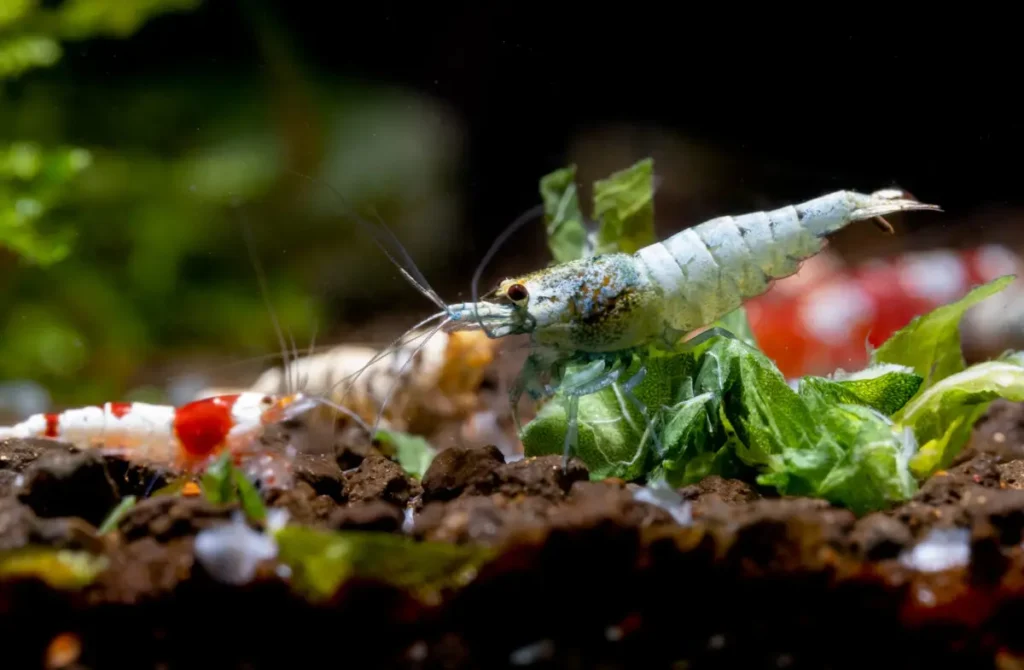
Providing shrimp with a balanced diet helps to prevent nutritional deficiencies and related health issues. It supports their immune system, enhances reproductive capabilities, and promotes vibrant colours and healthy growth. A well-rounded diet also contributes to your shrimp’s overall vitality and longevity.
Essential Nutrients for Shrimp Growth and Health
Shrimp have specific nutritional requirements that must be met for their optimal growth and health. Here are some essential nutrients they need:
- Proteins: Shrimp require high-quality protein sources to support muscle development and growth. Protein-rich foods include brine shrimp, daphnia, fish flakes, and pellets.
- Carbohydrates: Shrimp provide a source of energy from carbohydrates. They can derive these from vegetables, algae, and prepared shrimp foods.
- Fats: Shrimp need fats for energy storage and to support vital functions. These fats can be obtained from high-quality fish oils and other seafood-based foods.
- Vitamins: Shrimp require various vitamins to support their immune system and other physiological processes. Vitamin-rich foods include algae, leafy greens, and specially formulated shrimp vitamins.
- Minerals: Shrimp rely on minerals like calcium, magnesium, and potassium for shell development and the proper functioning of their internal systems. These minerals can be found in blanched vegetables, calcium-rich shrimp foods, and mineral supplements.
Varieties of Food in a Shrimp Diet
When planning a shrimp diet, it’s essential to offer a variety of foods to meet their nutritional needs. Here are some types of food that can be included in a shrimp diet:
| Type of Food | Description |
|---|---|
| Algae | Other foods, such as brine shrimp, daphnia, bloodworms, and mosquito larvae, can be offered as occasional treats to provide variety and additional nutrients. |
| Blanched Vegetables | Vegetables like spinach, zucchini, and cucumber can provide additional nutrition to shrimp. Ensure they are blanched to make them easily digestible. |
| Prepared Aquarium Foods | Commercially available shrimp pellets, flakes, and granules are formulated to meet the specific nutritional requirements of shrimp. These can be used as a primary or supplemental food source. |
| Supplemental Foods | Other foods like brine shrimp, daphnia, bloodworms, and mosquito larvae can be offered as occasional treats to provide variety and additional nutrients. |
By incorporating various foods into a shrimp diet, you can ensure they receive a well-rounded nutrition to support their overall health and vitality.
Shrimp Feeding Schedule: How Often to Feed
Determining the appropriate feeding frequency is essential for maintaining the health and well-being of your shrimp. Consistency and regularity in their feeding schedule ensure they receive nutrients and thrive in their aquatic environment.
When it comes to how often to feed your shrimp, there are a few factors to consider, including their age, size, and species. Adult shrimp should generally be fed once or twice daily, while younger shrimp may require more frequent feedings. It is essential to monitor their feeding habits and adjust the schedule to meet their needs.
Remember, overfeeding can be detrimental to the health of your shrimp and can lead to poor water quality and other related issues. It’s better to underfeed slightly than to overfeed your shrimp. By observing their behaviour and adjusting the feeding schedule accordingly, you can ensure they receive the proper amount of food without causing harm.
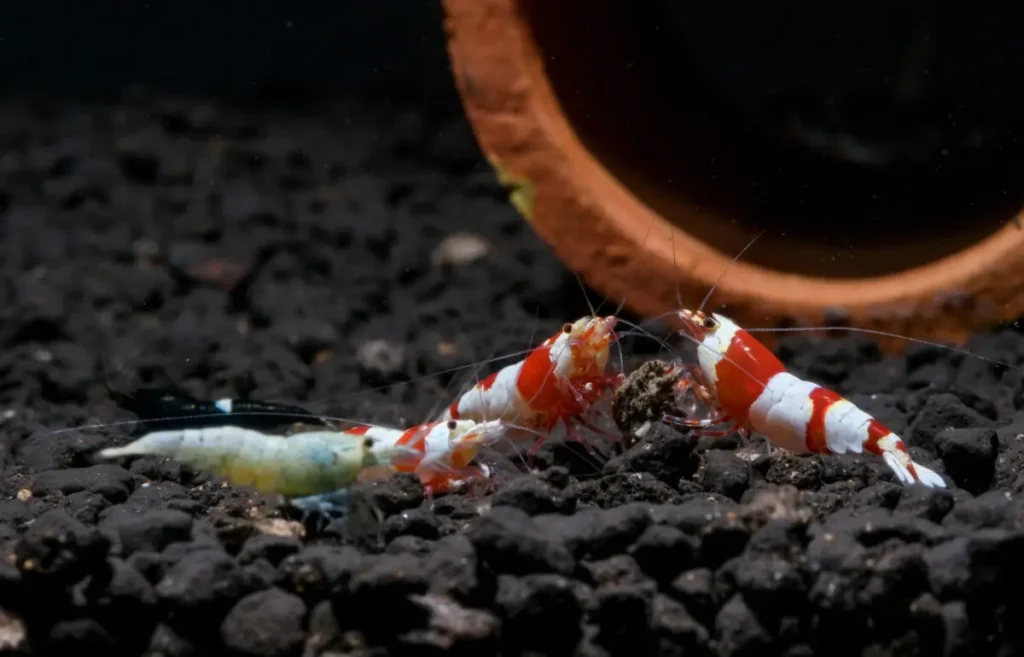
In addition to the regular feeding schedule, providing a varied diet for your shrimp is essential. This helps ensure they receive a balanced nutritional intake. Consider offering a mix of natural foods such as algae, blanched vegetables, live or frozen organisms, and high-quality commercial shrimp foods.
By following a consistent and appropriate feeding schedule tailored to your shrimp’s needs, you can help promote their overall health and vitality.
Best Practices for Feeding Freshwater Shrimp
When it comes to feeding Freshwater shrimp, it’s essential to establish a feeding routine that meets their specific needs. Customizing their feeding routine ensures they receive the proper nutrition for optimal health and vitality. Understanding their feeding behaviour and providing supplemental foods can further enhance their well-being.
Customizing the Freshwater Shrimp Feeding Routine
Creating a customized feeding routine for Freshwater shrimp involves considering their natural feeding patterns and tank conditions. While Freshwater shrimp are known for their ability to scavenge and feed on biofilm, they must supplement their diet with additional foods to meet their nutritional requirements. A varied diet that includes high-quality pellets, algae wafers, and blanched vegetables can ensure they receive a balanced diet.
When determining the feeding frequency, it’s generally recommended to feed Freshwater shrimp once or twice daily. However, monitoring their feeding behaviour and adjusting the feeding routine is crucial. Overfeeding can lead to poor water quality and negatively impact their overall health. Conversely, underfeeding may result in nutrient deficiencies and stunted growth. Regular observation and adjustment are vital to maintaining a healthy feeding routine.
Recognizing Feeding Behaviors in Freshwater Shrimp
Observing Freshwater shrimp’s feeding behaviours can provide valuable insights into their nutritional needs. They are typically active during the evening or night when the lights are dim or turned off. Freshwater shrimp will actively forage and graze on surfaces, such as plants and decorations, in search of food.
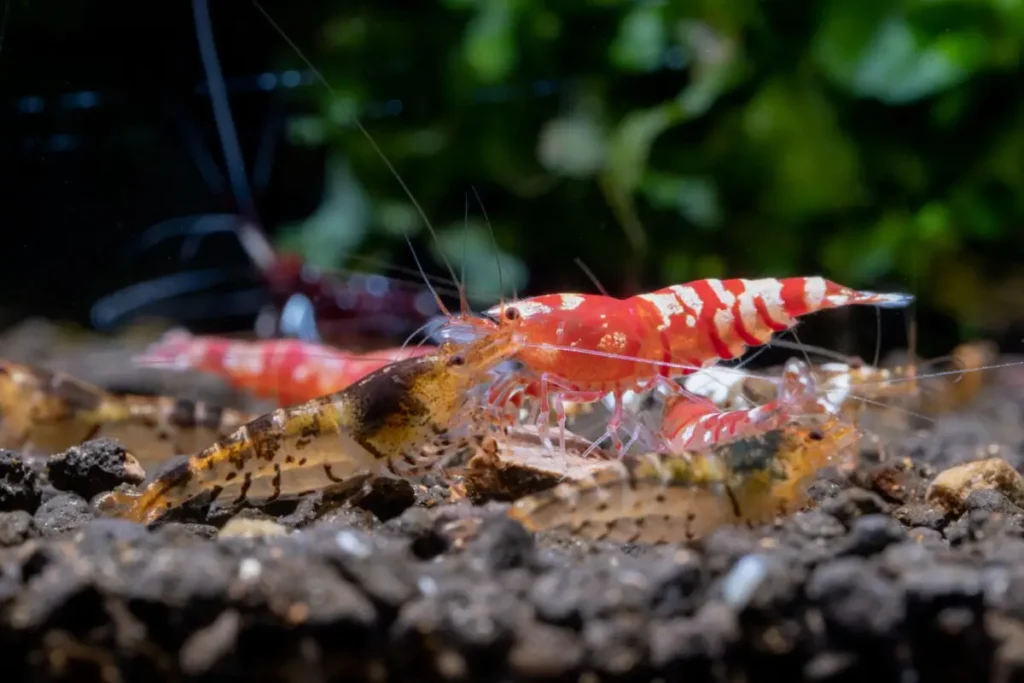
They use their small pincer appendages to scrape biofilm and other food particles. By closely monitoring their feeding activities, you can ensure they have access to enough food and adjust the feeding routine as needed.
Supplemental Foods for Freshwater Shrimp
In addition to their main diet, Freshwater shrimp can benefit from supplemental foods that provide essential nutrients. These foods can enhance colouration, promote breeding, and support overall health. Some popular supplemental foods for cherry shrimp include:
- Chlorella powder: Rich in vitamins and minerals, it can boost their immune system and enhance their colouration. It can be sprinkled directly into the tank for easy consumption.
- Indian almond leaves: Indian almond leaves release beneficial compounds into the water, creating a natural environment for cherry shrimp. They also provide a source of biofilm and serve as a supplemental food.
- Bacter AE: This specialized shrimp food contains essential amino acids and probiotics. It helps promote digestive health and boosts the overall well-being of cherry shrimp.
- Vegetables: Blanched vegetables such as spinach, zucchini, or cucumber can be added to the tank as a source of additional nutrition. They should be prepared appropriately and removed after the shrimp have consumed the soft parts.
Incorporating these supplemental foods into their diet ensures that Freshwater shrimp receive a wide range of essential nutrients for their thriving.
| Supplemental Food | Benefits |
|---|---|
| Chlorella powder | Rich in vitamins and minerals, it enhances colouration and boosts the immune system. |
| Indian almond leaves | Creates a natural environment, provides biofilm, supports overall health |
| Bacter AE | Contains essential amino acids and probiotics, promotes digestive health |
| Vegetables | Spinach, zucchini, or cucumber, a source of additional nutrition, should be adequately prepared and removed after consumption. |
Determining the Right Shrimp Feeding Amount
Determining the right feeding amount is crucial for their health and well-being when keeping shrimp. Providing them with an appropriate quantity of food ensures they receive the necessary nutrients without being overfed.
To calculate the proper feeding amount for your shrimp, consider several factors:
- Size and Age: Larger and older shrimp generally require more food than smaller and younger ones. Adjust the feeding amount accordingly to meet their individual needs.
- Activity Level: Shrimp that are more active and constantly foraging may need slightly more food to sustain their energy levels.
- Tank Conditions: Consider the overall condition of your tank, including the presence of other tankmates and the availability of natural food sources. Adjust the feeding amount based on the available resources.
Observing your shrimp during feeding is essential to determine if the amount provided is sufficient or needs adjustment. If you notice uneaten food lingering in the tank after feeding, consider reducing the amount to avoid overfeeding and potential water quality issues.
Remember, it’s better to underfeed your shrimp than to overfeed them slightly. Overfeeding can lead to water contamination, increased ammonia levels, and detrimental effects on the overall health of your shrimp. Calculating the appropriate feeding amount and monitoring their behaviour ensures your shrimp remain healthy and thrive in their aquatic environment.
Preventing Overfeeding in Shrimp Tanks
Preventing overfeeding is crucial for maintaining the health and well-being of shrimp in a tank. Overfeeding can lead to various issues, including poor water quality, algae blooms, and health problems for the shrimp. By being mindful of the signs of overfeeding and implementing proper feeding management strategies, you can ensure the optimal health of your shrimp.
Signs of Overfeeding and Its Effects
Several signs indicate overfeeding in shrimp tanks. These include uneaten food accumulating on the substrate, increased waste production, and declining water quality parameters such as elevated ammonia and nitrate levels. Overfeeding can also result in excessive algae growth, leading to imbalances in the tank ecosystem. Moreover, shrimp may experience health issues such as obesity, decreased growth rates, and susceptibility to diseases due to an imbalanced diet.
Managing Leftover Food and Tank Cleanliness
Leftover food must be managed to prevent overfeeding, and the tank must be cleaned and maintained. One effective strategy is to feed small amounts of food at a time, ensuring the shrimp consume all the food within a few minutes. If any food remains uneaten, it should be promptly removed from the tank to prevent it from decomposing and negatively affecting water quality.
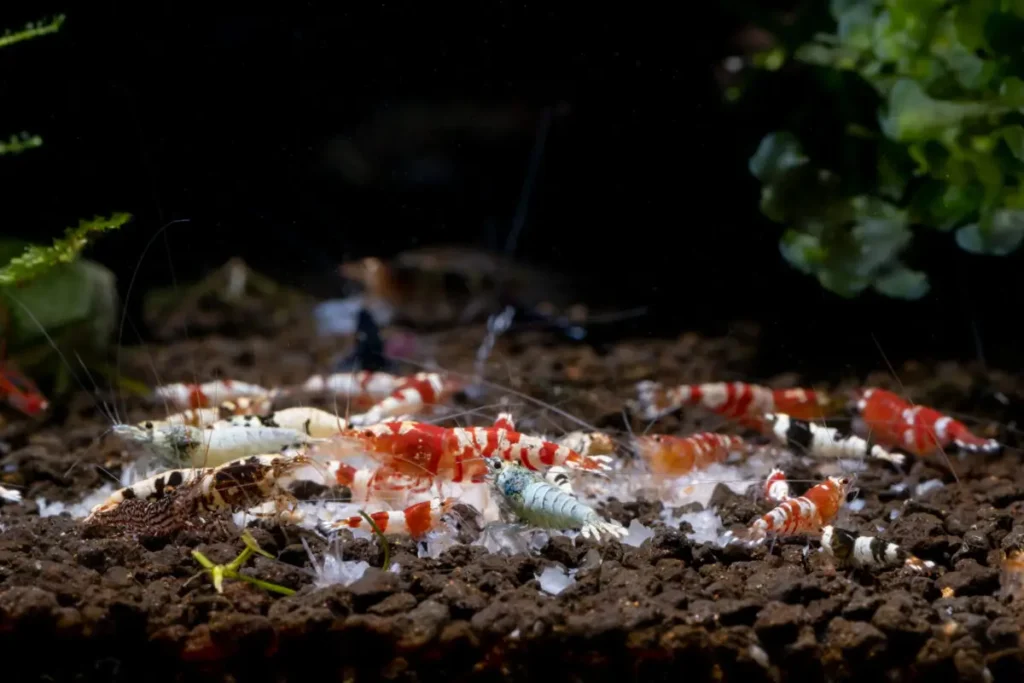
Regular water changes and mechanical filtration can also help remove excess nutrients and waste, reducing the risk of overfeeding-related problems.
Additionally, it is advisable to regularly clean the tank substrate and remove any debris or decaying matter. This helps maintain a clean and healthy environment for the shrimp, reducing the chances of overfeeding and associated issues.
Adjusting Feeding Quantities for Optimal Health
Adjusting feeding quantities based on shrimp’s needs is essential to ensuring optimal health. Factors such as the shrimp’s size, species, and age should be considered when determining the appropriate amount of food to provide. Regularly monitoring the shrimp’s body condition and overall health can help determine whether the feeding quantity needs to be adjusted. It is vital to balance providing enough nutrition for the shrimp’s well-being and avoiding excessive feeding that can lead to overfeeding-related problems.
You can promote your shrimp’s overall health and vitality by preventing overfeeding, managing leftover food, maintaining tank cleanliness, and adjusting feeding quantities.
Natural and Commercial Foods: A Comprehensive Guide
When providing the best possible diet for your shrimp, it’s essential to consider both natural and commercial food options. This comprehensive guide will help you understand the benefits and considerations of each type of food, allowing you to create a well-rounded nutrition plan for your shrimp.
Natural Foods for Shrimp
Natural foods can be a great source of nutrition for shrimp. They mimic the diet that shrimp consume in their natural habitat and can help promote their overall health and well-being. Some popular natural foods for shrimp include:
- Algae: Shrimp love to graze on algae, which provides essential nutrients and fibre.
- Blanched Vegetables: Vegetables like spinach, zucchini, and lettuce can be blanched and then offered to shrimp as a nutritious food source.
- Biofilm: Biofilm forms on surfaces in the aquarium and is a natural food source that shrimp can graze on.
Commercial Shrimp Foods
Commercial shrimp foods are specifically formulated to meet shrimp’s nutritional needs. They often contain a combination of high-quality ingredients that provide the necessary proteins, vitamins, and minerals. Some common types of commercial shrimp foods include:
- Pellets: Pellets are a convenient and easy-to-feed option that typically contains a balanced mix of nutrients for shrimp.
- Wafers: Wafers are designed to sink to the bottom of the tank, making them ideal for bottom-dwelling shrimp species.
- Flakes: Flakes are another popular option and can be easily consumed by adult and juvenile shrimp.
Creating a Balanced Diet
It’s essential to incorporate natural and commercial shrimp foods into their diet to provide the best nutrition for your shrimp. This allows them to enjoy the benefits of the various nutrients in different food sources. By offering a variety of foods, you can ensure that your shrimp receive a well-rounded diet that supports their growth and overall health.
| Food Type | Benefits | Considerations |
|---|---|---|
| Natural Foods | – Mimics natural diet – Provides important nutrients – Promotes overall health | – Availability may vary – Requires preparation and monitoring – Can contribute to algae growth |
| Commercial Shrimp Foods | – Specifically formulated – Convenient and easy to feed – Provides essential nutrients | – May require additional supplementation – Costlier than natural foods – Limited variety |
By offering a combination of natural and commercial shrimp foods, you can ensure your shrimp receives a diverse and nutrient-rich diet. Remember to monitor their response to different foods and adjust as needed to provide optimal nutrition.
Feeding Baby Shrimp: Special Considerations
Feeding baby shrimp requires special attention and consideration to ensure their healthy growth and development. Here are some essential factors to keep in mind when feeding these delicate shrimp:
Importance of Diet Variety For Juvenile Shrimp
Diet variety is crucial for juvenile shrimp as it provides the essential nutrients for their overall well-being. A diverse range of foods helps promote healthy growth and supports their nutritional needs. Incorporating a mix of protein-rich foods, plant matter, and synthetic foods ensures that baby shrimp receive a well-rounded diet.
Scheduling Feeds for Young Shrimp Growth
Establishing a feeding schedule is vital for young shrimp’s growth. It is recommended that baby shrimp be fed multiple times a day to ensure they receive an adequate amount of nutrition.
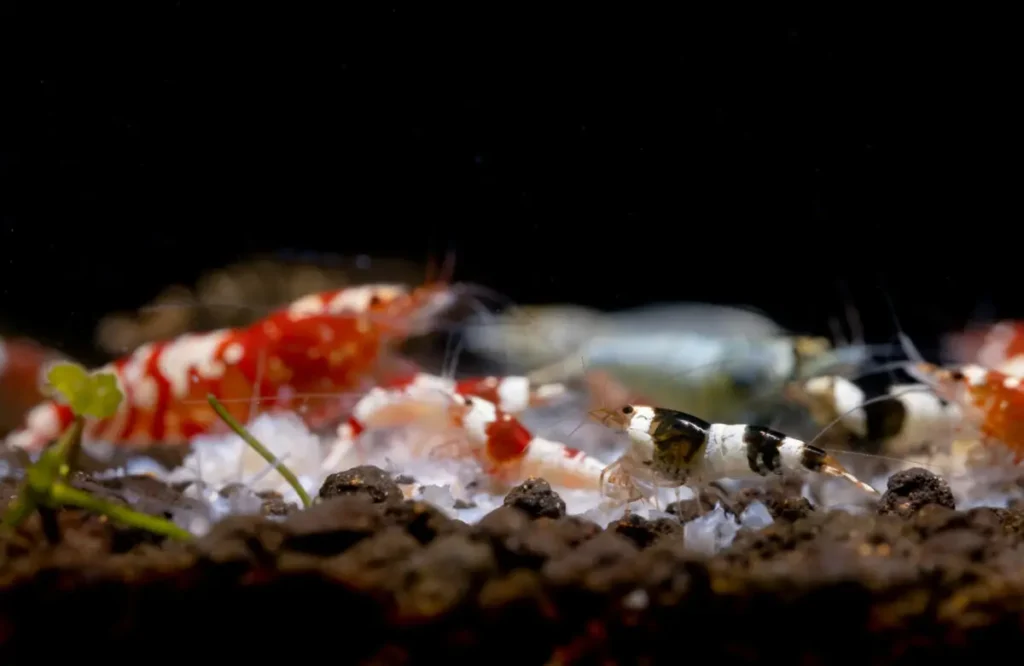
A regular feeding routine helps maintain consistent growth and provides the necessary energy for shrimp development. Adjusting the feeding frequency based on the shrimp’s size and age ensures proper nourishment.
Utilizing Powder Foods for Easy Access
Powdered foods are a practical option when feeding baby shrimp. These finely ground foods are easily accessible to the tiny shrimp, allowing them to consume the necessary nutrients effortlessly. Powder foods are often formulated to cater specifically to the nutritional needs of baby shrimp. Additionally, they help maintain water quality by reducing waste and uneaten food in the tank.
Proper nutrition and care during the early stages of a shrimp’s life are crucial for their long-term health. You can ensure your baby shrimp’s healthy growth and development by offering a diverse diet, scheduling feeds, and utilizing powdered foods.
| Benefits of Diet Variety for Juvenile Shrimp | Scheduling Feeds for Young Shrimp Growth | Advantages of Using Powder Foods |
|---|---|---|
| 1. Provides essential nutrients | 1. Ensures regular and consistent growth | 1. Easily accessible to small shrimp |
| 2. Supports overall well-being | 2. Supplies necessary energy for development | 2. Tailored to the nutritional needs of baby shrimp |
| 3. Promotes healthy growth | 3. Adjusts feeding frequency for optimal nourishment | 3. Reduces waste and maintains water quality |
Conclusion
In conclusion, establishing an optimal shrimp feeding schedule is crucial for maintaining the health and well-being of your shrimp. Throughout this article, we have explored various critical aspects of shrimp feeding, including understanding their nutritional requirements, determining the right feeding amount, and preventing overfeeding.
By providing a balanced diet that meets their nutritional needs, you can ensure the growth and vitality of your shrimp. It is essential to include a variety of foods in their diet, such as algae, blanched vegetables, and prepared aquarium foods. Regularly monitoring their feeding habits and adjusting as needed will help maintain their overall health.
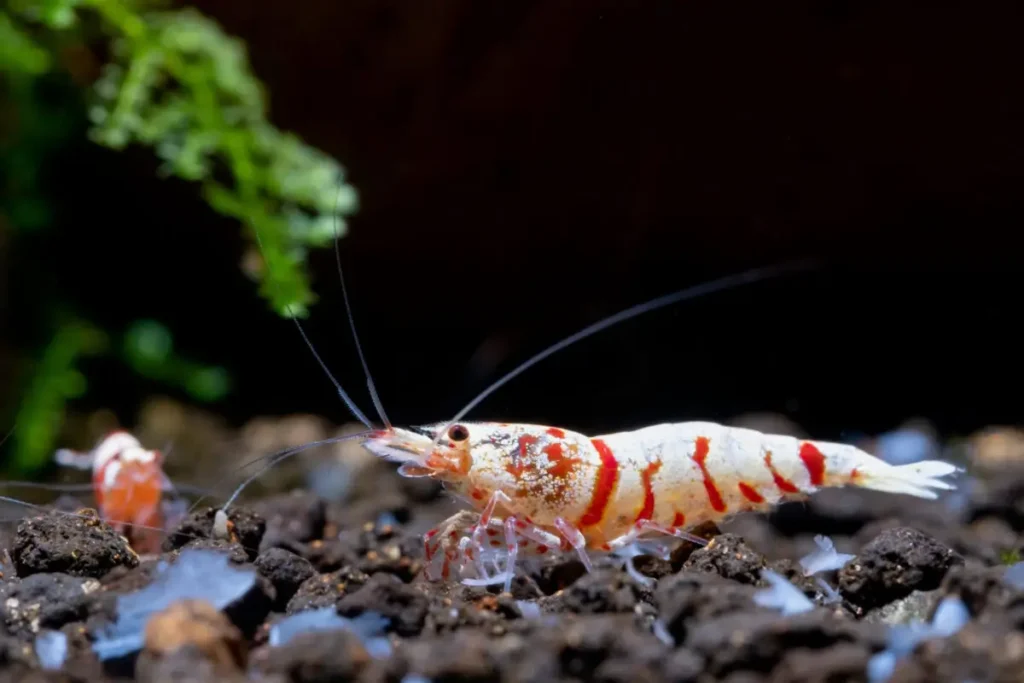
Preventing overfeeding is equally essential for the long-term health of your shrimp. By recognizing the signs of overfeeding and managing leftover food, you can maintain optimal water quality and prevent potential health issues. Adjusting feeding quantities based on the condition of your shrimp and overall tank conditions will also contribute to their well-being.
As a shrimp keeper, it is crucial to be mindful of the unique feeding requirements of baby shrimp. Providing a varied diet and scheduling feeds according to their growth stages will promote healthy development. Utilizing powdered foods can be a convenient option for ensuring easy access to essential nutrition for baby shrimp.
In summary, a well-planned shrimp feeding schedule and a balanced and varied diet will lay the foundation for your shrimp’s overall health and vibrancy. Following the guidelines outlined in this article, you can create an optimal feeding routine that will promote their growth, enhance their colours, and increase their lifespan. Remember to always prioritize quality over quantity and observe your shrimp’s behaviour and health to make any necessary adjustments. Happy feeding!

